engine TOYOTA PRIUS 2009 2.G Service Manual
[x] Cancel search | Manufacturer: TOYOTA, Model Year: 2009, Model line: PRIUS, Model: TOYOTA PRIUS 2009 2.GPages: 508, PDF Size: 6.84 MB
Page 451 of 508
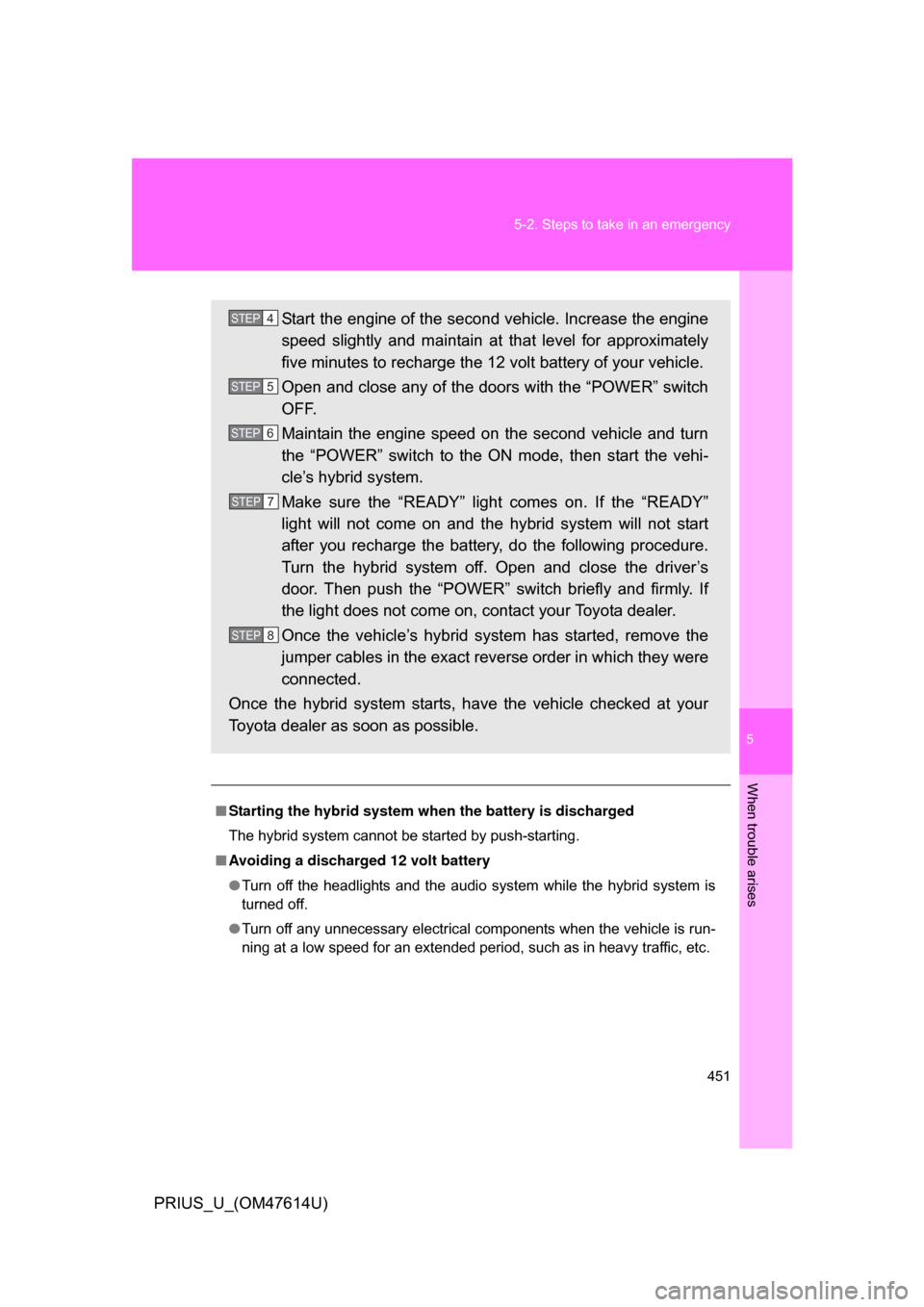
5
When trouble arises
451
5-2. Steps to take in an emergency
PRIUS_U_(OM47614U)
■
Starting the hybrid system when the battery is discharged
The hybrid system cannot be started by push-starting.
■ Avoiding a discharged 12 volt battery
● Turn off the headlights and the audio system while the hybrid system is
turned off.
● Turn off any unnecessary electrical components when the vehicle is run-
ning at a low speed for an extended period, such as in heavy traffic, etc.
Start the engine of the second vehicle. Increase the engine
speed slightly and maintain at that level for approximately
five minutes to recharge the 12 volt battery of your vehicle.
Open and close any of the doors with the “POWER” switch
OFF.
Maintain the engine speed on the second vehicle and turn
the “POWER” switch to the ON mode, then start the vehi-
cle’s hybrid system.
Make sure the “READY” light comes on. If the “READY”
light will not come on and the hybrid system will not start
after you recharge the battery, do the following procedure.
Turn the hybrid system off. Open and close the driver’s
door. Then push the “POWER” switch briefly and firmly. If
the light does not come on, contact your Toyota dealer.
Once the vehicle’s hybrid syst em has started, remove the
jumper cables in the exact reverse order in which they were
connected.
Once the hybrid system starts, have the vehicle checked at your
Toyota dealer as soon as possible.STEP4
STEP5
STEP6
STEP7
STEP8
Page 454 of 508
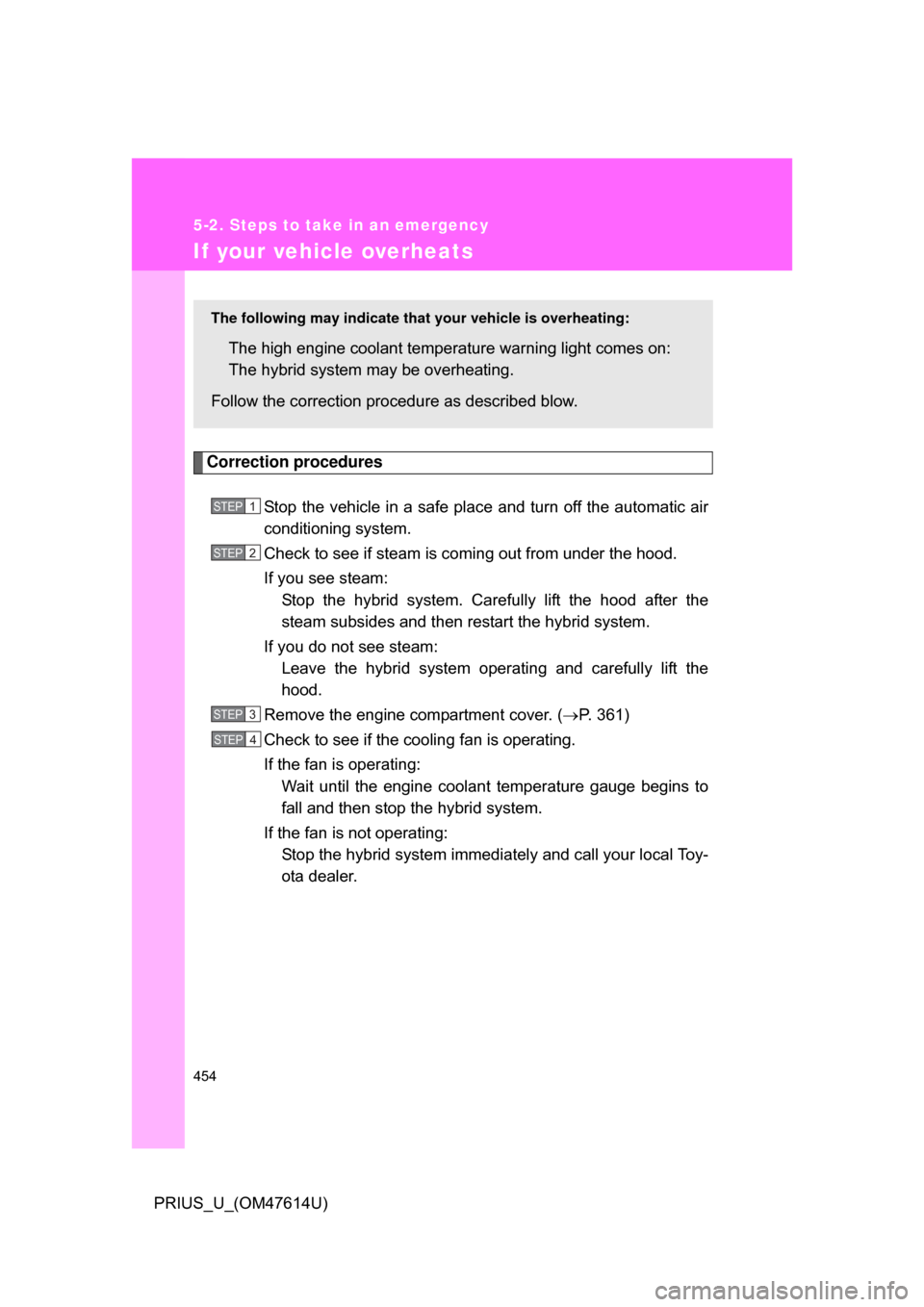
454
5-2. Steps to take in an emergency
PRIUS_U_(OM47614U)
If your vehicle overheats
Correction proceduresStop the vehicle in a safe place and turn off the automatic air
conditioning system.
Check to see if steam is coming out from under the hood.
If you see steam: Stop the hybrid system. Carefully lift the hood after the
steam subsides and then restart the hybrid system.
If you do not see steam: Leave the hybrid system operating and carefully lift the
hood.
Remove the engine compartment cover. ( P. 361)
Check to see if the cooling fan is operating.
If the fan is operating: Wait until the engine coolant temperature gauge begins to
fall and then stop the hybrid system.
If the fan is not operating: Stop the hybrid system immediately and call your local Toy-
ota dealer.
The following may indicate that your vehicle is overheating:
The high engine coolant temperature warning light comes on:
The hybrid system may be overheating.
Follow the correction procedure as described blow.
STEP1
STEP2
STEP3
STEP4
Page 456 of 508
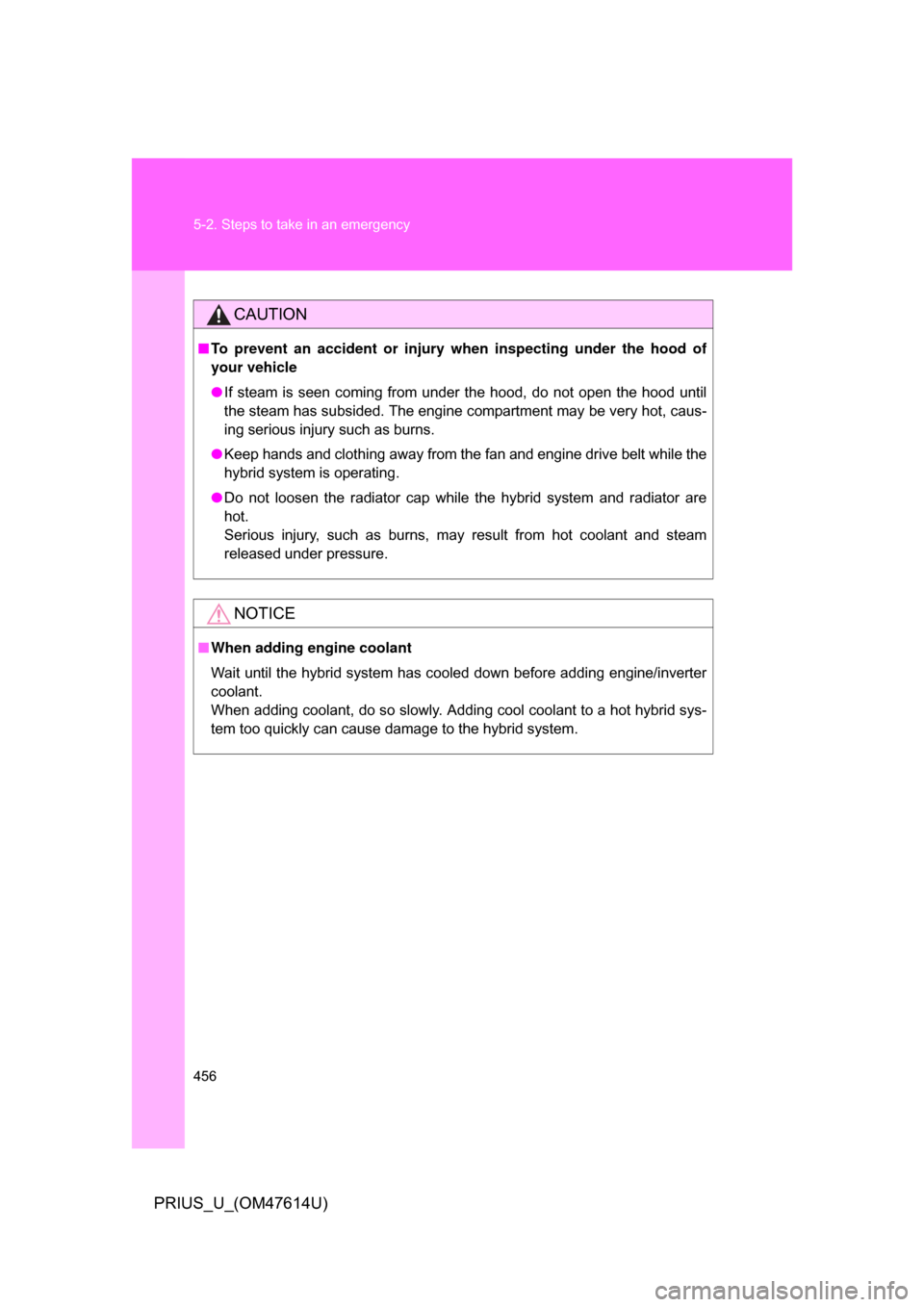
456 5-2. Steps to take in an emergency
PRIUS_U_(OM47614U)
CAUTION
■To prevent an accident or injury when inspecting under the hood of
your vehicle
● If steam is seen coming from under the hood, do not open the hood until
the steam has subsided. The engine compartment may be very hot, caus-
ing serious injury such as burns.
● Keep hands and clothing away from the fan and engine drive belt while the
hybrid system is operating.
● Do not loosen the radiator cap while the hybrid system and radiator are
hot.
Serious injury, such as burns, may result from hot coolant and steam
released under pressure.
NOTICE
■When adding engine coolant
Wait until the hybrid system has cooled down before adding engine/inverter
coolant.
When adding coolant, do so slowly. Adding cool coolant to a hot hybrid sys-
tem too quickly can cause damage to the hybrid system.
Page 461 of 508
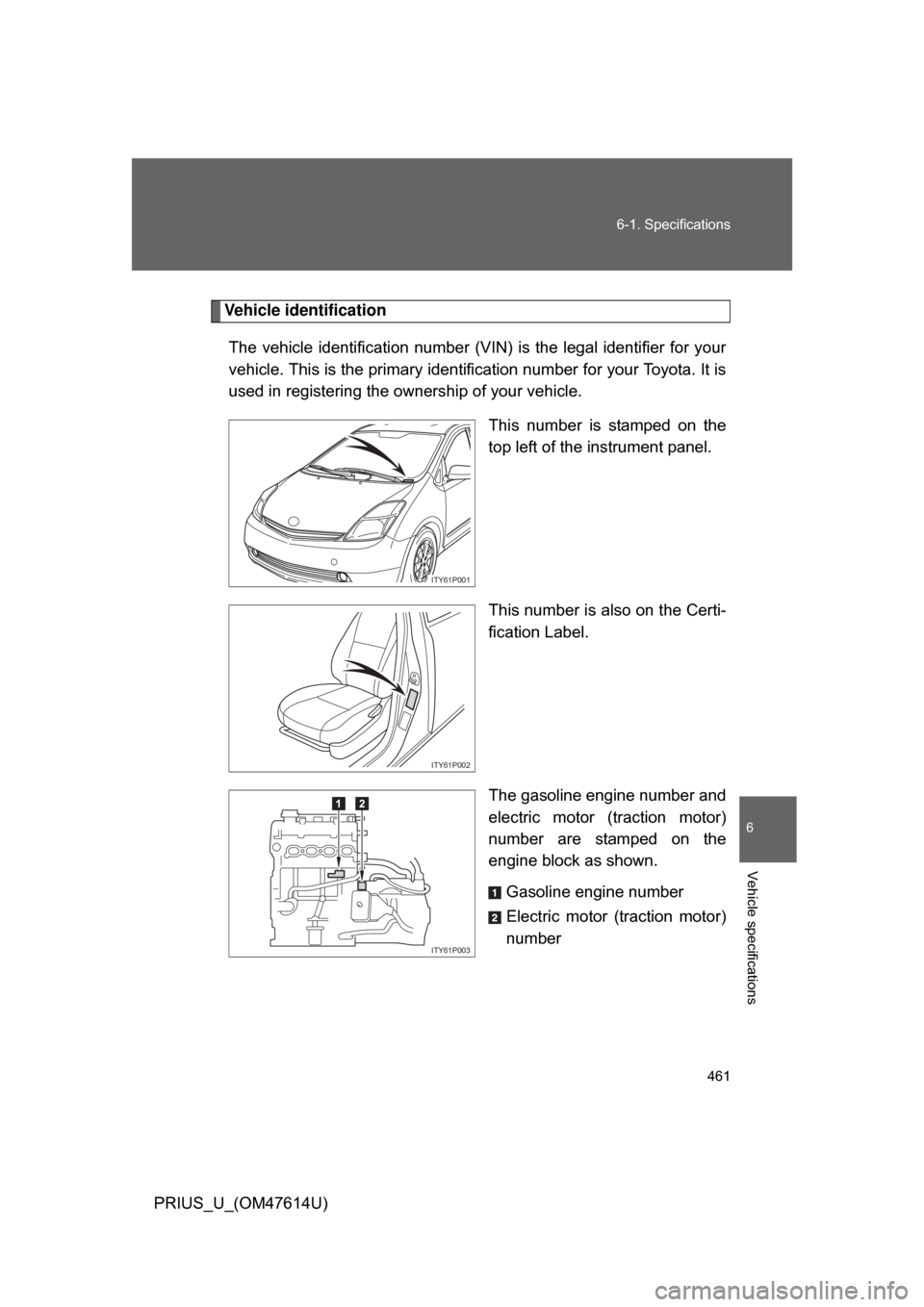
461
6-1. Specifications
6
Vehicle specifications
PRIUS_U_(OM47614U)
Vehicle identification
The vehicle identificati on number (VIN) is the legal identifier for your
vehicle. This is the primary identification number for your Toyota. It is
used in registering the ownership of your vehicle.
This number is stamped on the
top left of the instrument panel.
This number is also on the Certi-
fication Label.
The gasoline engine number and
electric motor (traction motor)
number are stamped on the
engine block as shown.Gasoline engine number
Electric motor (traction motor)
number
ITY61P001
ITY61P002
ITY61P003
Page 462 of 508
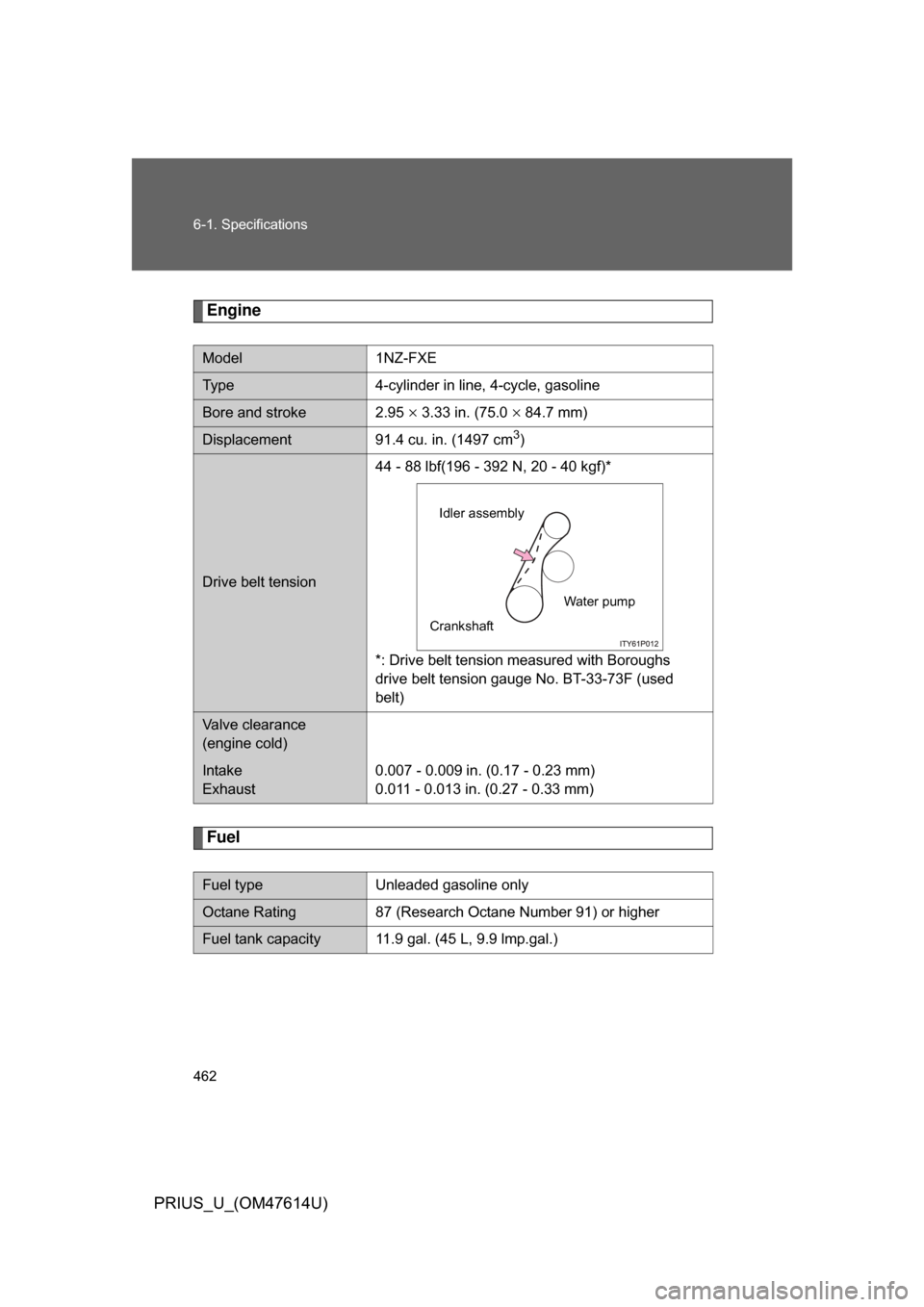
462 6-1. Specifications
PRIUS_U_(OM47614U)
Engine
Fuel
Model1NZ-FXE
Type4-cylinder in line, 4-cycle, gasoline
Bore and stroke 2.95 3.33 in. (75.0 84.7 mm)
Displacement91.4 cu. in. (1497 cm3)
Drive belt tension 44 - 88 lbf(196 - 392 N, 20 - 40 kgf)*
*: Drive belt tension measured with Boroughs
drive belt tension gauge No. BT-33-73F (used
belt)
Valve clearance
(engine cold)
Intake
Exhaust
0.007 - 0.009 in. (0.17 - 0.23 mm)
0.011 - 0.013 in. (0.27 - 0.33 mm)
Fuel typeUnleaded gasoline only
Octane Rating
87 (Research Octane Number 91) or higher
Fuel tank capacity 11.9 gal. (45 L, 9.9 lmp.gal.)
Idler assembly
Crankshaft Water pump
Page 464 of 508
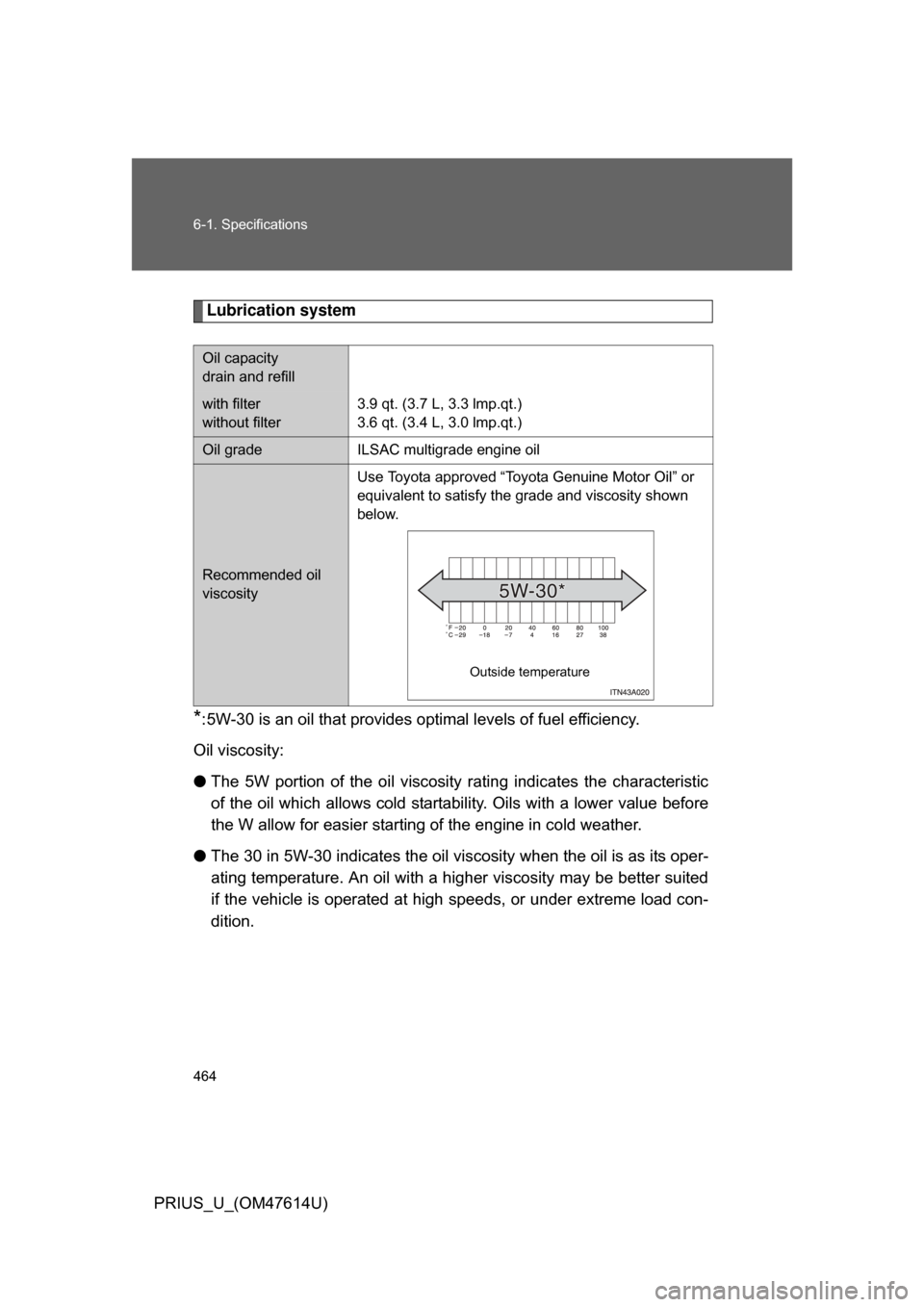
464 6-1. Specifications
PRIUS_U_(OM47614U)
Lubrication system
*:5W-30 is an oil that provides optimal levels of fuel efficiency.
Oil viscosity:
● The 5W portion of the oil viscosity rating indicates the characteristic
of the oil which allows cold startab ility. Oils with a lower value before
the W allow for easier starting of the engine in cold weather.
● The 30 in 5W-30 indicates the oil viscosity when the oil is as its oper-
ating temperature. An oil with a higher viscosity may be better suited
if the vehicle is operated at high speeds, or under extreme load con-
dition.
Oil capacity
drain and refill
with filter
without filter 3.9 qt. (3.7 L, 3.3 lmp.qt.)
3.6 qt. (3.4 L, 3.0 lmp.qt.)
Oil grade
ILSAC multigrade engine oil
Recommended oil
viscosityUse Toyota approved “Toyota Genuine Motor Oil” or
equivalent to satisfy the grade and viscosity shown
below.
Outside temperature
Page 465 of 508
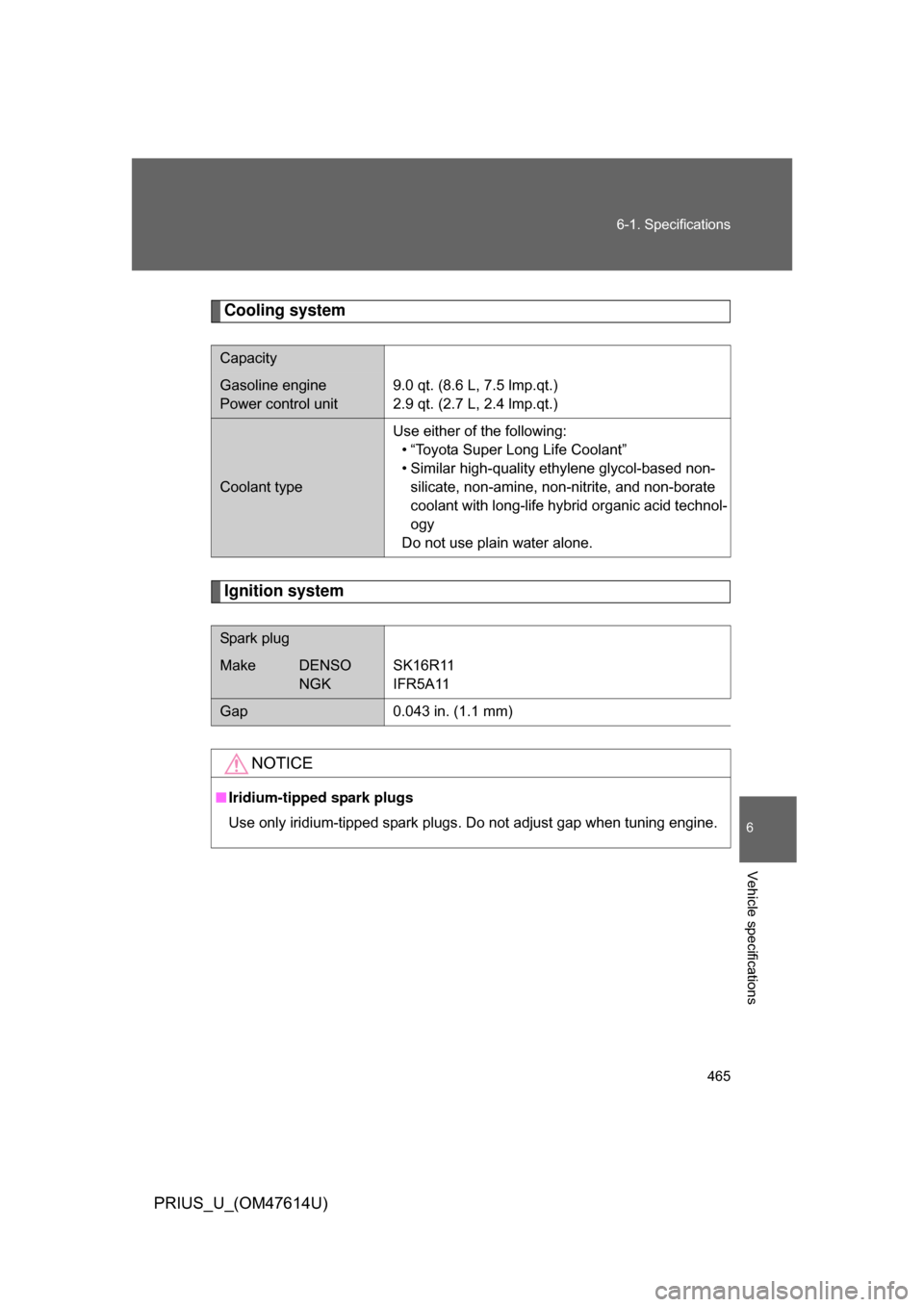
465
6-1. Specifications
6
Vehicle specifications
PRIUS_U_(OM47614U)
Cooling system
Ignition system
Capacity
Gasoline engine
Power control unit
9.0 qt. (8.6 L, 7.5 lmp.qt.)
2.9 qt. (2.7 L, 2.4 lmp.qt.)
Coolant typeUse either of the following:
• “Toyota Super Long Life Coolant”
• Similar high-quality ethylene glycol-based non-silicate, non-amine, non-nitrite, and non-borate
coolant with long-life hybrid organic acid technol-
ogy
Do not use plain water alone.
Spark plug
Make DENSO NGK SK16R11
IFR5A11
Gap
0.043 in. (1.1 mm)
NOTICE
■Iridium-tipped spark plugs
Use only iridium-tipped spark plugs. Do not adjust gap when tuning engine.
Page 470 of 508
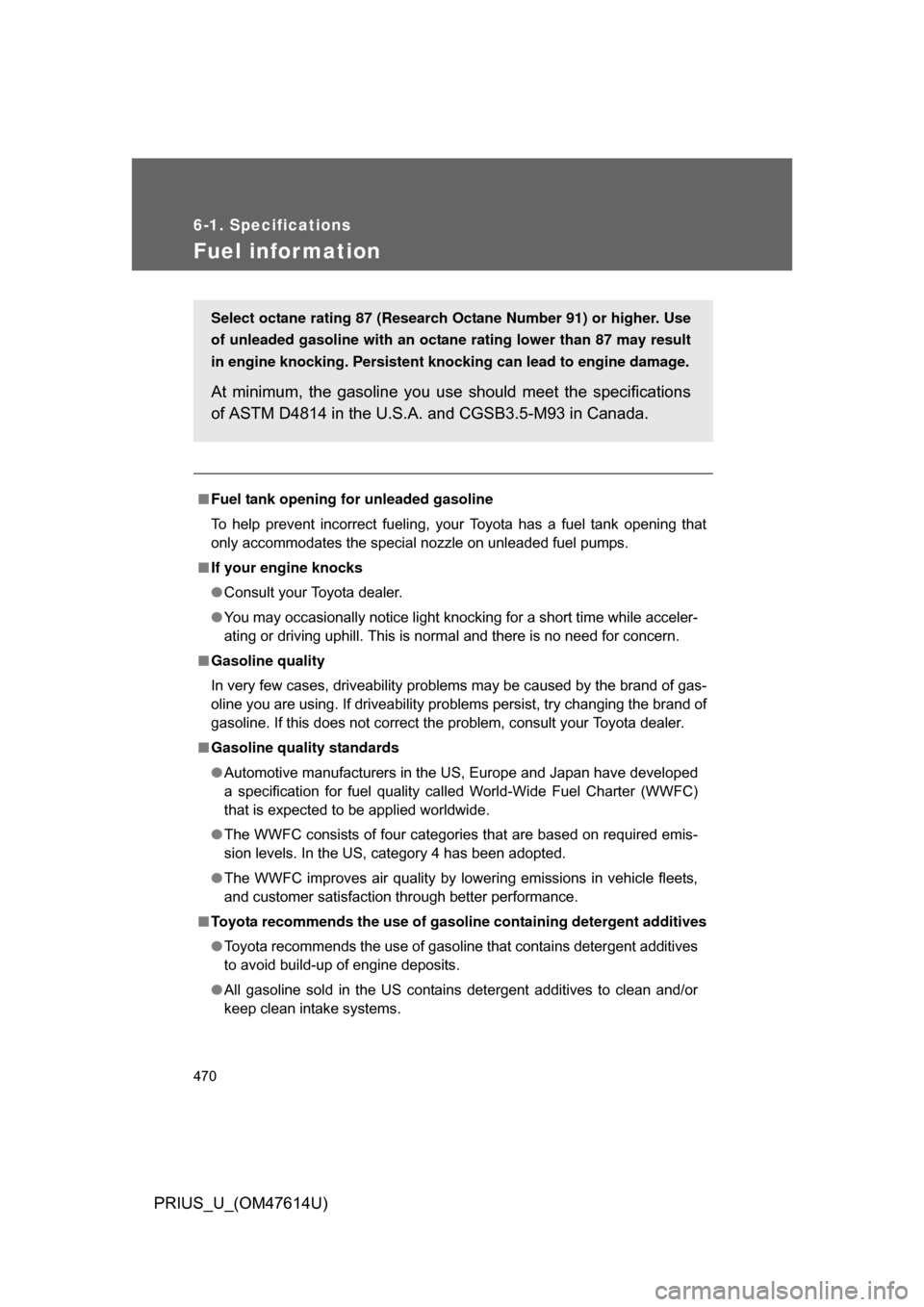
470
6-1. Specifications
PRIUS_U_(OM47614U)
Fuel infor mation
■Fuel tank opening fo r unleaded gasoline
To help prevent incorrect fueling, your Toyota has a fuel tank opening that
only accommodates the special nozzle on unleaded fuel pumps.
■ If your engine knocks
● Consult your Toyota dealer.
● You may occasionally notice light knocking for a short time while acceler-
ating or driving uphill. This is normal and there is no need for concern.
■ Gasoline quality
In very few cases, driveability problems may be caused by the brand of gas-
oline you are using. If driveability problems persist, try changing the brand of
gasoline. If this does not correct the problem, consult your Toyota dealer.
■ Gasoline quality standards
● Automotive manufacturers in the US, Europe and Japan have developed
a specification for fuel quality called World-Wide Fuel Charter (WWFC)
that is expected to be applied worldwide.
● The WWFC consists of four categories that are based on required emis-
sion levels. In the US, category 4 has been adopted.
● The WWFC improves air quality by lowering emissions in vehicle fleets,
and customer satisfaction through better performance.
■ Toyota recommends the use of gaso line containing detergent additives
● Toyota recommends the use of gasoline that contains detergent additives
to avoid build-up of engine deposits.
● All gasoline sold in the US contains detergent additives to clean and/or
keep clean intake systems.
Select octane rating 87 (Research Octane Number 91) or higher. Use
of unleaded gasoline with an octane rating lower than 87 may result
in engine knocking. Persistent kno cking can lead to engine damage.
At minimum, the gasoline you use should meet the specifications
of ASTM D4814 in the U.S.A. and CGSB3.5-M93 in Canada.
Page 472 of 508
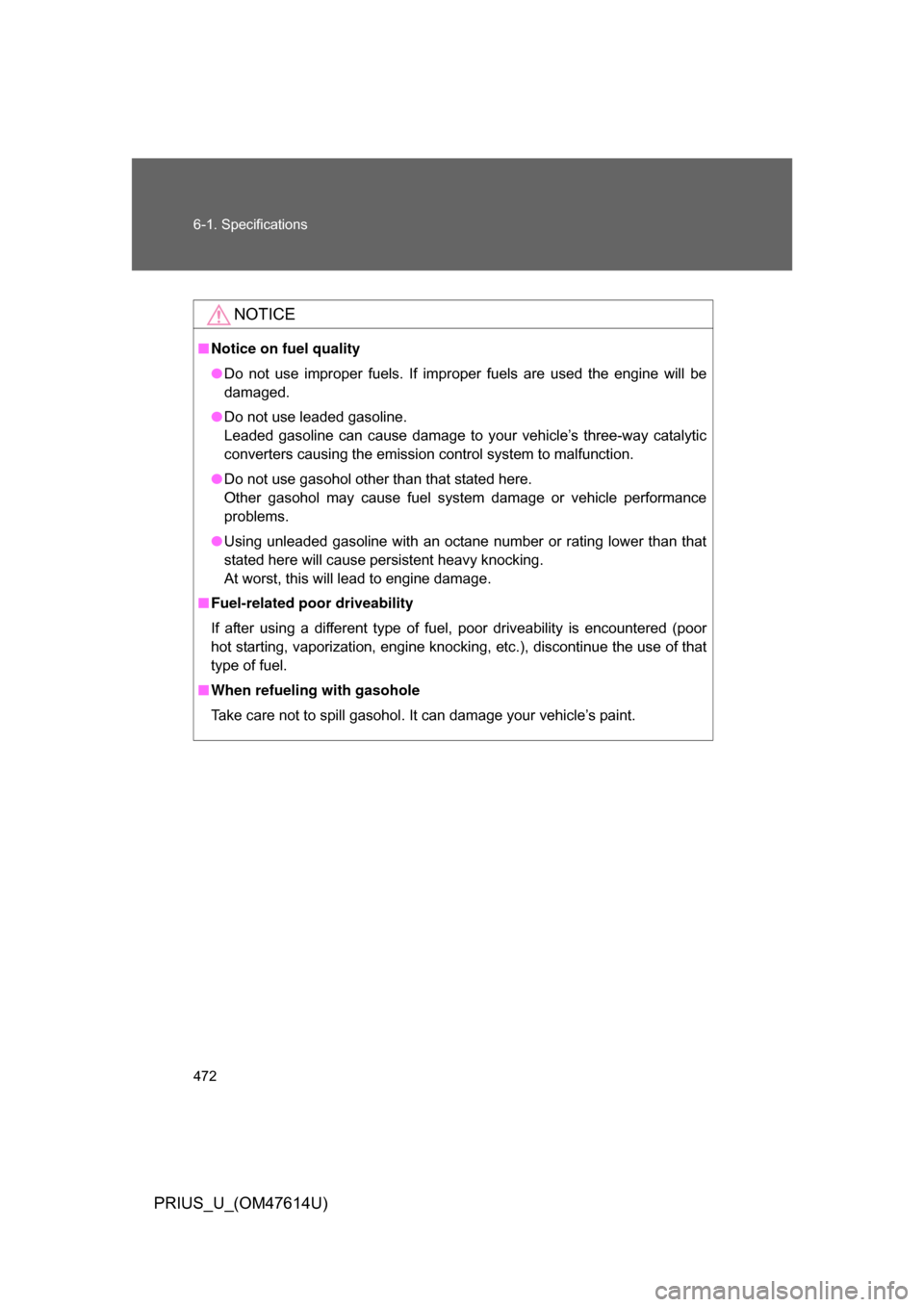
472 6-1. Specifications
PRIUS_U_(OM47614U)
NOTICE
■Notice on fuel quality
● Do not use improper fuels. If improper fuels are used the engine will be
damaged.
● Do not use leaded gasoline.
Leaded gasoline can cause damage to your vehicle’s three-way catalytic
converters causing the emission control system to malfunction.
● Do not use gasohol other than that stated here.
Other gasohol may cause fuel system damage or vehicle performance
problems.
● Using unleaded gasoline with an octane number or rating lower than that
stated here will cause persistent heavy knocking.
At worst, this will lead to engine damage.
■ Fuel-related p oor driveability
If after using a different type of fuel, poor driveability is encountered (poor
hot starting, vaporization, engine knocking, etc.), discontinue the use of that
type of fuel.
■ When refueling with gasohole
Take care not to spill gasohol. It can damage your vehicle’s paint.
Page 479 of 508
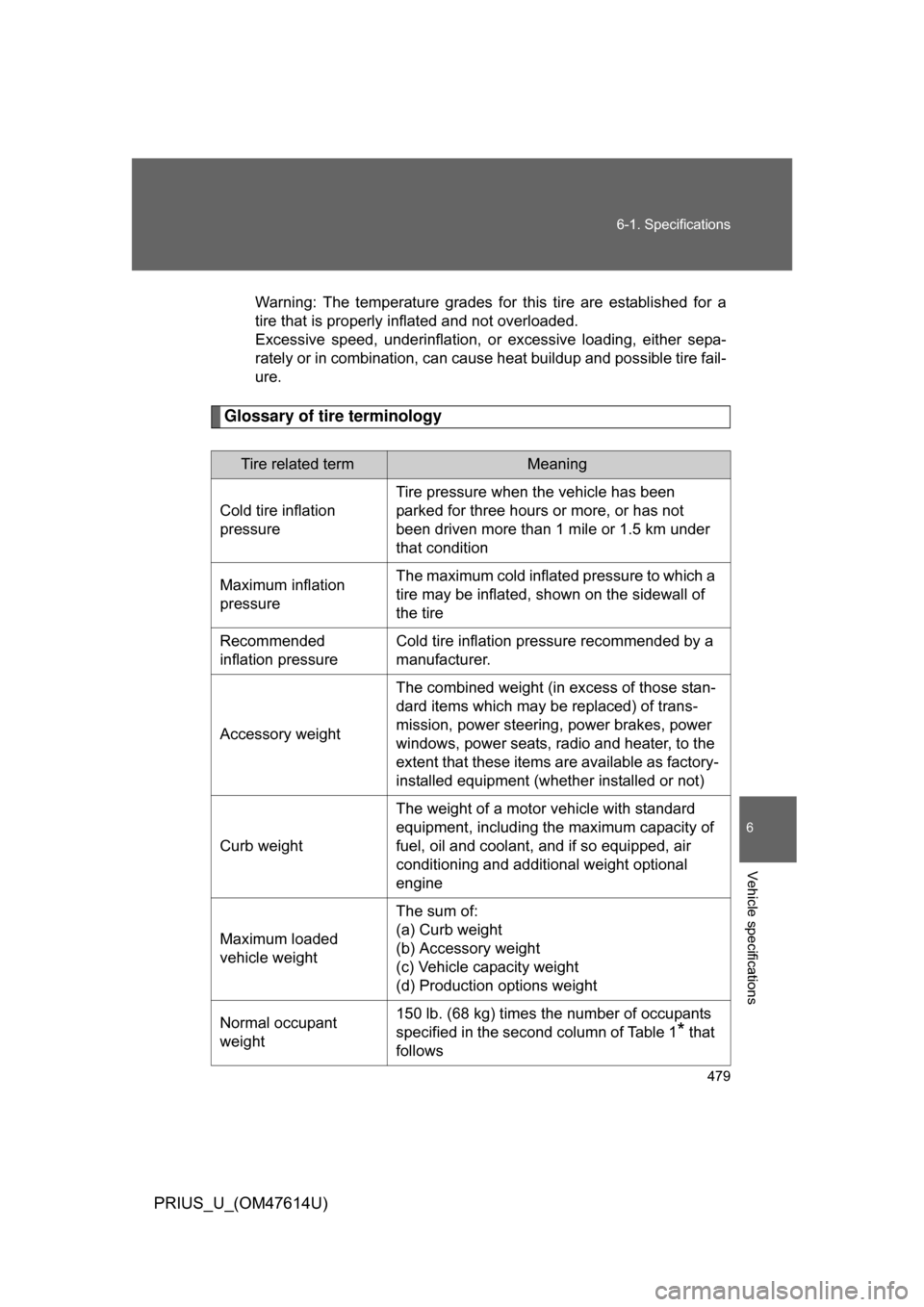
479
6-1. Specifications
6
Vehicle specifications
PRIUS_U_(OM47614U)
Warning: The temperature grades for this tire are established for a
tire that is properly inflated and not overloaded.
Excessive speed, underinflation, or
excessive loading, either sepa-
rately or in combination, can caus e heat buildup and possible tire fail-
ure.
Glossary of tire terminology
Tire related termMeaning
Cold tire inflation
pressure Tire pressure when the vehicle has been
parked for three hours or more, or has not
been driven more than 1 mile or 1.5 km under
that condition
Maximum inflation
pressure The maximum cold inflated
pressure to which a
tire may be inflated, s hown on the sidewall of
the tire
Recommended
inflation pressure Cold tire inflation pressure recommended by a
manufacturer.
Accessory weight The combined weight (in excess of those stan-
dard items which may be replaced) of trans-
mission, power steering, power brakes, power
windows, power seats, radio and heater, to the
extent that these items
are available as factory-
installed equipment (whether installed or not)
Curb weight The weight of a motor vehicle with standard
equipment, including the maximum capacity of
fuel, oil and coolant, and if so equipped, air
conditioning and additional weight optional
engine
Maximum loaded
vehicle weight The sum of:
(a) Curb weight
(b) Accessory weight
(c) Vehicle capacity weight
(d) Production options weight
Normal occupant
weight 150 lb. (68 kg) times the number of occupants
specified in the second column of Table 1
* that
follows